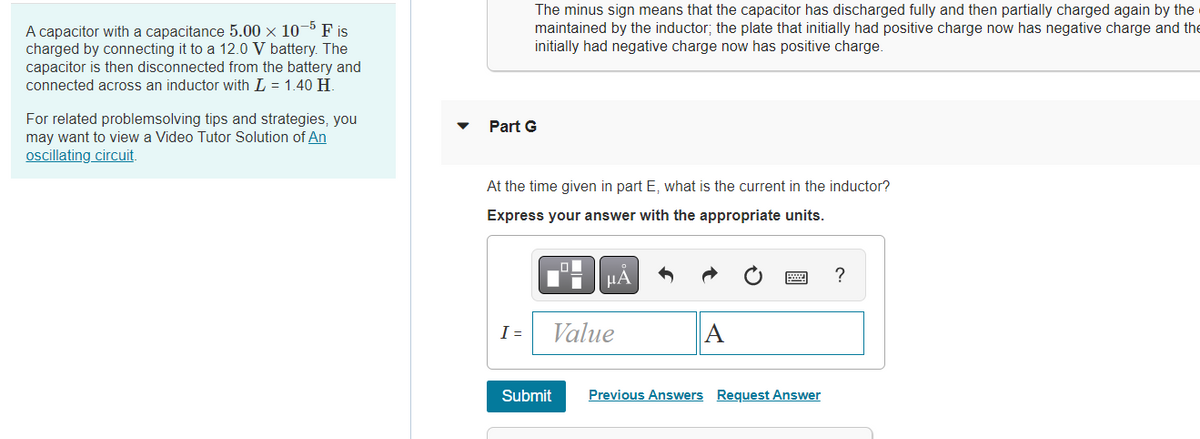A capacitor with a capacitance 5.00 × 10-5 F is charged by connecting it to a 12.0 V battery. The capacitor is then disconnected from the battery and connected across an inductor with L = 1.40 H.
A capacitor with a capacitance 5.00 × 10-5 F is charged by connecting it to a 12.0 V battery. The capacitor is then disconnected from the battery and connected across an inductor with L = 1.40 H.
Principles of Physics: A Calculus-Based Text
5th Edition
ISBN:9781133104261
Author:Raymond A. Serway, John W. Jewett
Publisher:Raymond A. Serway, John W. Jewett
Chapter23: Faraday’s Law And Inductance
Section: Chapter Questions
Problem 7OQ
Related questions
Question
ω =120 rad/s
|
T =
|
5.26×10−2 s
|
|
Q =
|
6.00×10−4 C initial charge
|

Transcribed Image Text:A capacitor with a capacitance 5.00 × 10-5 F is
charged by connecting it to a 12.0 V battery. The
capacitor is then disconnected from the battery and
connected across an inductor with L = 1.40 H.
For related problemsolving tips and strategies, you
may want to view a Video Tutor Solution of An
oscillating circuit.
The minus sign means that the capacitor has discharged fully and then partially charged again by the
maintained by the inductor; the plate that initially had positive charge now has negative charge and the
initially had negative charge now has positive charge.
Part G
At the time given in part E, what is the current in the inductor?
Express your answer with the appropriate units.
I =
μA
Value
Submit
A
Previous Answers Request Answer
?
Expert Solution
This question has been solved!
Explore an expertly crafted, step-by-step solution for a thorough understanding of key concepts.
This is a popular solution!
Trending now
This is a popular solution!
Step by step
Solved in 2 steps

Knowledge Booster
Learn more about
Need a deep-dive on the concept behind this application? Look no further. Learn more about this topic, physics and related others by exploring similar questions and additional content below.Recommended textbooks for you

Principles of Physics: A Calculus-Based Text
Physics
ISBN:
9781133104261
Author:
Raymond A. Serway, John W. Jewett
Publisher:
Cengage Learning

Physics for Scientists and Engineers: Foundations…
Physics
ISBN:
9781133939146
Author:
Katz, Debora M.
Publisher:
Cengage Learning

Physics for Scientists and Engineers with Modern …
Physics
ISBN:
9781337553292
Author:
Raymond A. Serway, John W. Jewett
Publisher:
Cengage Learning

Principles of Physics: A Calculus-Based Text
Physics
ISBN:
9781133104261
Author:
Raymond A. Serway, John W. Jewett
Publisher:
Cengage Learning

Physics for Scientists and Engineers: Foundations…
Physics
ISBN:
9781133939146
Author:
Katz, Debora M.
Publisher:
Cengage Learning

Physics for Scientists and Engineers with Modern …
Physics
ISBN:
9781337553292
Author:
Raymond A. Serway, John W. Jewett
Publisher:
Cengage Learning

Physics for Scientists and Engineers
Physics
ISBN:
9781337553278
Author:
Raymond A. Serway, John W. Jewett
Publisher:
Cengage Learning

Physics for Scientists and Engineers, Technology …
Physics
ISBN:
9781305116399
Author:
Raymond A. Serway, John W. Jewett
Publisher:
Cengage Learning

College Physics
Physics
ISBN:
9781938168000
Author:
Paul Peter Urone, Roger Hinrichs
Publisher:
OpenStax College